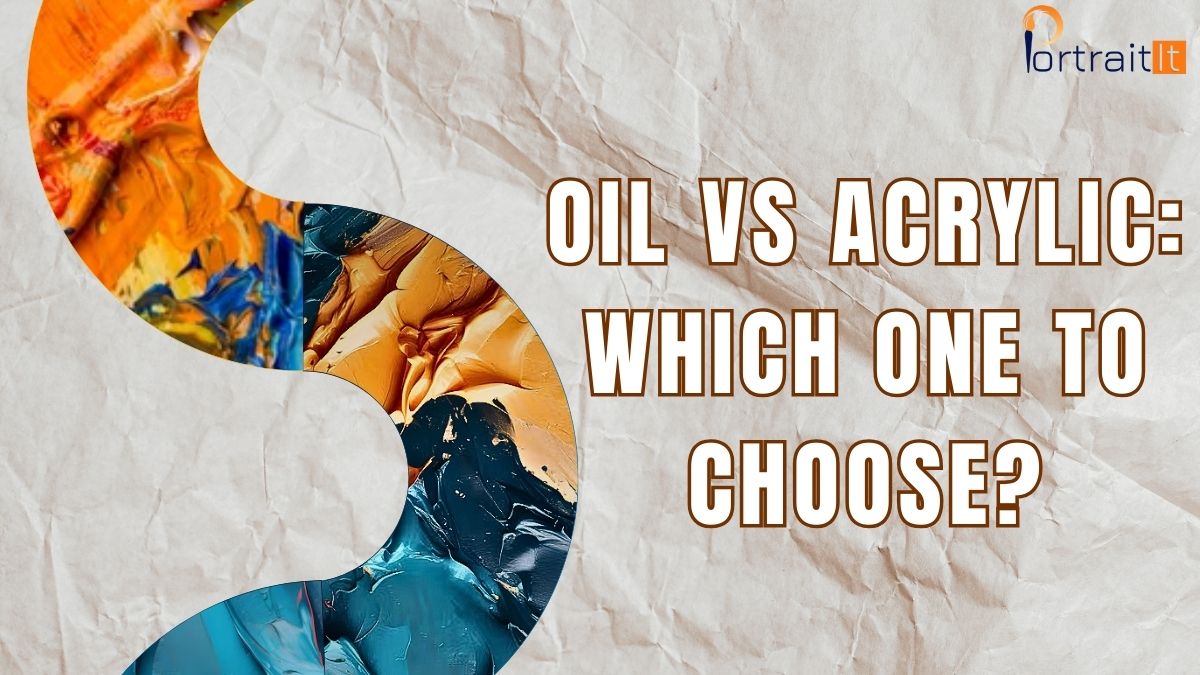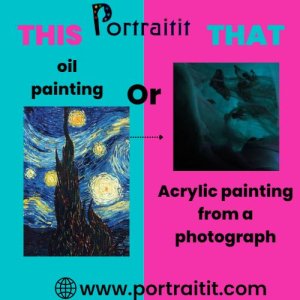Oil or Acrylic painting from a photograph?
Since the dawn of time, man has wanted to express his need to feel emotions, especially by portraying them out of something that is a need. Painting is one medium, we humans have chosen from the beginning of time to express ourselves.
When we look at a painting, the message is always something different from what we gather from those around us. As a beginner or somebody who has gotten themselves in awe of paintings hanging around in exhibitions, it is important to understand what you have gotten yourselves in.
There are various ways artists choose to color a painting, the main two are oil and acrylic painting from a photograph.
Let us first dive into the meaning of the colors.
What is an oil painting from a picture?
The most well-known paintings in the entire world are frequently oil painting from a picture. As one of the most respected and well-liked mediums for artists’ colour, oil paints have been used for centuries. Best known professional artists have also frequently used oils as a medium of choice, and they have a solid reputation.
The pigment is combined with a drying agent, oil produced from linseed or rather walnut oil, to produce oil paints. Because oils counteract the passing of light, they give the paint a glossier appearance and feel. Drying oils dry through the process of oxidation and the process of polymerization. They form a film on the surface of the paint, forming a barrier between paint layers even if additional layers are applied over them.
What is acrylic painting from a photograph?
Paintings made with acrylic painting from a photograph that has been diluted with water are known as acrylic paintings. It is well-known for its properties such as quick-drying and the ease of application while painting, but it somehow still lacks waterproofing. Acrylic paints have been made from acrylic acid, that is also found in products including such Plexiglas and also Lucite.
The most crucial component of acrylic is that it tends to dry rapidly and can be used on any exterior without having left stains or destroying the surface due to its water-soluble properties.
What is the difference between Oil and acrylic painting from a photograph?
| Headers | Oil painting from a picture | Acrylic painting from a photograph |
| Drying Time. | The paint takes longer to dry. | The paint dries easily. |
| Supplies. | Expensive Supplies are needed to paint an oil painting. | Cheap and available supplies everywhere are accessible. |
| Duration. | The paint takes up a lot of time to work with. | Quickly paint application is done on the paintings. |
| Place. | Use of oil painting in a well-ventilated place.
(It has the use of turpentine in the paint, which can be harmful to your health if you use it in a confined place.) |
Use of Acrylic painting can be done in a confined-compact place.
(Only the use of water should be accessible, although ventilation is advised.) |
| Flexibility. | Oils can be used to accomplish the same thing, but the inner paint will remain slightly damp even when the outermost layers has hardened to the touch | Acrylics may be the right choice for you if you enjoy using a palette knife to create thick, brushstrokes paintings. Paint thickly and build it up; the paint will dry. |
| Yellowing. | Due to the hue of the oil (imagine olive oil), oil paints will exhibit a slight colouration of yellow undertone to them. As oil gets dry over time through the oxidation process extra yellowing occurs. The degree of this changes based on the binding agent used in the paint. | Acrylic binder is typically white but dries clear. This means that it appears lighter on the canvas when first applied and then darkens as the white binder dries.
This is especially evident when painting portraits. Turning around, you find that the colour has changed after you think you’ve nailed the precise hue.
|
| Colour Shift. | The binder agent in oil paints has the tendency to make oil paintings to change colour over time. | With administered laboratory tests acrylics won’t change in time, the colours will look the same now as they will in 150+ years. |
| Blending paint. | Oil paints are king of the ring when blending colours together. Because of the slow drying nature of oil paints they can be fantastic for creating subtle blends. | As a result of how quickly acrylics dry, blending can be difficult. |
| Crisp Edges. | To create a crisp edge without affecting the underlying colours with oils, you must wait until the next day or touch dry, otherwise your brushstroke will pull and mix with the paint beneath it. | Acrylics’ crisp edges can be extremely useful if you are painting with a more visual composition. A hard shape can be easily covered with thicker paint by masking off specific areas and quickly painting over them. You can easily mix clean, bright colours. |
Your Decision : Acrylic or Oil painting from a picture?
You can create a vivid picture using the oil painting from a picture technique, but it takes a lot of patience. Acrylic Painting, on the other hand, allows you to create sharp graphical paintings in just one sitting for a very low cost. The versatility and the magic of your colours if you choose oil or acrylic paint is going to create a massive difference in the context of your painting. Choosing to be budget conscious would be preferable only if you choose Acrylic painting from a photograph not Oil.
It is so to say that the medium of your painting would not be the determining factor to have the say if the painting is top notch or not but it resides with the value and ideas you have put onto the canvas.
Every coin, as we all know, has two sides. Oil paints and Acrylic painting from a photograph, similarly, have both positive and negative effects. Choosing the best painting medium for you should be easy now that you understand the differences between acrylic and oil paint. You’ve already made your decision.



